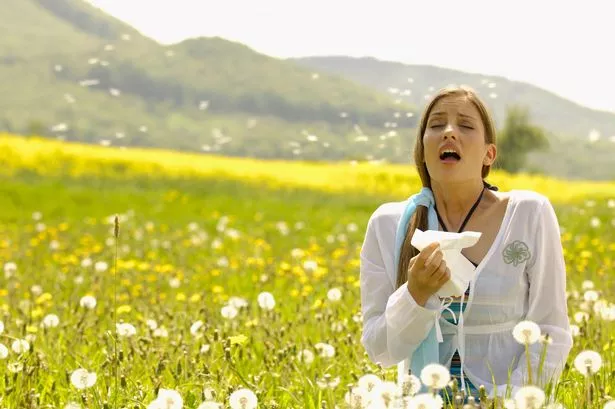As the anticipation of spring and summer builds, hayfever sufferers face an early challenge with a significant spike in pollen levels. Searches for ‘is hayfever bad today’ have surged by 750 percent in the last seven days, signaling an impending hayfever season. Swift Direct Blinds experts have shared invaluable insights on hayfever-proofing your home. Let’s explore five practical strategies to keep hayfever at bay this year.
1. Avoid Outdoor Drying:
Hanging clothes outside may seem like a delightful idea, but it’s a pollen trap waiting to infiltrate your home. As pollen builds up on outdoor-dried clothes, it becomes a carrier that spreads allergens indoors. To counter this, opt for indoor drying methods such as a tumble dryer or an indoor clothes horse.
2. Post-Outdoor Ritual:
After being outdoors, pollen adheres to your clothes, hair, and skin. Establish a post-outdoor ritual by leaving shoes at the entrance, changing clothes immediately, and taking a shower. This not only prevents pollen entry but also utilizes the benefits of steam to naturally alleviate allergy symptoms.
3. Flooring Matters:
Consider removing carpets, known pollen magnets, from your home. Hard flooring reduces pollen retention and eases symptoms for severe hayfever cases. If removing carpets isn’t feasible, increase vacuuming frequency to at least twice a week, focusing on pollen-prone areas.
4. Soft Furnishings Maintenance:
Soft furnishings like curtains, blinds, and pillows can accumulate pollen over time. Regularly wash these items, or for unwashable curtains, vacuum weekly using an upholstery attachment. This proactive approach keeps your living spaces from becoming pollen hotspots.
5. Seal the Entry Points:
Maintain a pollen-resistant environment by keeping windows and doors closed, especially during peak pollen times. In bedrooms, this is crucial for a good night’s sleep. If ventilation is necessary, opt for overnight hours when pollen counts are lower, or use closed blinds or curtains as a protective barrier.
Expert Tips from Kate Duckworth:
Kate Duckworth, Trends and Interior expert at Swift Direct Blinds, emphasizes the importance of creating an allergy-proof home. With nearly 10 million people suffering from hayfever annually, her tips provide a practical approach to mitigate pollen’s impact on daily life.
“Simple techniques can keep pollen and allergens out, making hayfever season more bearable for many.”

Navigating Pollen Allergies: Understanding the Surge in February
As February unfolds, so does an unwelcome guest – pollen allergies. Renowned pulmonologists, Dr. Hitesh Billa and Dr. Rohan R Naick, shed light on this seasonal challenge. Pollen allergies, also known as hay fever or allergic rhinitis, result from an immune system overreaction to harmless pollen particles.
Understanding the Allergic Response:
Dr. Billa explains that the immune system misidentifies pollen as a threat, triggering the release of histamine and other chemicals. This leads to symptoms like sneezing, congestion, itchy eyes, throat irritation, and, in severe cases, coughing or wheezing.
February’s Impact on Pollen Allergies:
Why does February intensify pollen issues? Dr. Billa points to multiple factors, including the flowering season of trees like cedar, pine, and cypress. Dry weather and increased wind activity in February facilitate pollen dispersal. Agricultural practices like crop burning and urbanization further contribute, making February challenging for pollen allergy sufferers.
Managing Pollen Allergies:
Dr. Naick emphasizes a multi-pronged approach to manage pollen allergies, including avoidance strategies, medications, and allergen immunotherapy. As February marks the beginning of heightened pollen production, proactive measures become crucial.
Hay Fever Prevention Tips for the Coming Spring
GP Helen Wall provides timely advice for hayfever sufferers to get ahead of spring symptoms. With tree pollen levels rising and grass pollen on the horizon, taking preventive measures now can significantly reduce discomfort during peak pollen season.
Antihistamines for Early Defense:
GP Wall recommends starting antihistamines two to four weeks before symptoms peak. These readily available medications block histamine receptors, preventing the exaggerated immune response that leads to hayfever symptoms.
Proper Use of Nasal Steroid Sprays:
For severe symptoms, nasal steroid sprays are effective but often misused. GP Wall advises proper application by shaking the spray, directing it toward the nostril’s outer side, tipping the head forward, and breathing normally to ensure inhalation rather than ingestion.
Unusually Warm Temperatures Trigger Early Allergy Season in Europe
In Europe, unusually warm temperatures have set off allergy season earlier than usual. Dr. Madeleine Epstein, an allergy doctor in Paris, notes an increase in pollen impacting more individuals. Climate physics researcher Davide Faranda explains how winds contribute to pollen dispersion, emphasizing the role of warmer temperatures.
Tree Pollen Starting Early:
Hazelnut and alder tree pollen, along with Cupressaceae pollen, are notably increasing, heightening allergy risks. Karl-Christian Bergmann from the German Pollen Information Service Foundation highlights a trend of earlier tree pollen starts in the last two decades, influenced by high temperatures.
Climate Change and Allergy Season:
Climate change, marked by warmer temperatures and increased CO2 emissions, is extending the pollen season. Bergmann notes a shift from allergen-free periods 20 years ago to a continuous presence of pollen in the air. Atmospheric pollution interacts with pollen, exacerbating allergy symptoms.
In conclusion, combating the early pollen onslaught requires a proactive approach. By implementing expert-recommended strategies, understanding the seasonal dynamics, and embracing preventive measures, hayfever sufferers can navigate the challenges of an early allergy season with resilience and comfort.
